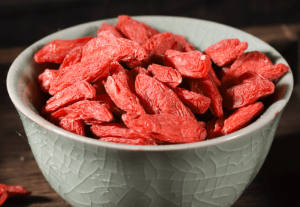Expert Reminder: When Buying Goji Berries, Don’t be Deceived by the “Appearance”

Many people are accustomed to adding a few Goji berries when cooking soup, steeping tea, or making porridge, hoping to enhance their health. However, if the Goji berries you buy appear overly vibrant, they may be harmful rather than beneficial because they might have undergone dyeing. What are the safety hazards of dyed Goji berries, and how can consumers distinguish them?
Professor Liu Shaowei, a member of the expert group of the New York Food Safety Research Association, said in an interview with Consumer Reports that dyed Goji berries are mainly of two types. One involves using dyes to enhance the appearance of aged goods, making the Goji berries look bright and enticing. The other type involves fumigating harvested Goji berries with sulfur, making the skin of the berries dry and bright, preventing pests, and extending the shelf life.
Liu Shaowei explained that Goji berries have a high sugar content, with over 10 grams of total sugar per 100 grams of fresh Goji berries, which is conducive to microbial growth and attracts insects. Additionally, Goji berries contain carotene and polyphenols, and these polyphenols are prone to enzymatic reactions, causing browning and affecting the appearance and sale of Goji berries.
The most common methods for pest control and color protection involve using sulfur dioxide. According to the national standard GB2760-2011 “Food Additives Standard,” sulfur dioxide and its sulfite class can be used in various foods such as dried fruits and candied fruits, but the residue limit is very strictly regulated. Generally, the residual amount of sulfur dioxide in Goji berries should not exceed 50 mg/kg or 100 mg/kg.
Liu Shaowei pointed out that the main problem with the fumigation of Goji berries is that some unscrupulous vendors use industrial sulfur, which is strictly prohibited for food, and some excessively use sodium metabisulfite, resulting in excessive sulfur dioxide.
The Joint Expert Committee on Food Additives and the World Health Organization stipulate that the daily safe intake limit of sulfur dioxide is not more than 0.7 mg/kg (intake/weight) for an adult. For example, a person weighing 60 kg should not exceed 42 mg per day. If Goji berries are only used as a seasoning or side dish, the problem may not be significant. However, if used as medicine or steeped in water for daily consumption, the risk is relatively high. Especially for individuals sensitive to sulfur dioxide, such as asthma patients, ingestion of sulfur dioxide may cause symptoms such as nausea, vomiting, abdominal pain, dizziness, and difficulty breathing.
Liu Shaowei reminded consumers that natural Goji berries are mostly reddish or dark red, with a deeper carrot red color. Dyed or fumigated Goji berries are often bright red and more uniform in color. When soaked in clear water for about 20 minutes, the color of dyed berries will turn red. Good Goji berries have a natural fragrance, while those fumigated with sulfur, besides being more vibrant in color, emit a strong or faint pungent odor and taste sour, bitter, and astringent.
Hits: 30
Dear readers and friends 🌟,
Thank you for your continuous support to our blog! We have always been committed to presenting content that is deep, interesting, and valuable for you. However, we understand that this is not an easy task.
Each article is the result of careful planning, writing, and editing. We invest a significant amount of time and effort, hoping to provide you with genuinely meaningful information and inspiration. Yet, our efforts can sometimes get lost in the vast sea of the online world.
That's why we need your help! If you find a particular article inspiring or believe its content can help others, consider sharing it on your social platforms. Whether it's on Facebook, Twitter, LinkedIn, or any other platform, your shares are not only support for our team but also a means of spreading valuable information and influencing more people.
Remember, each click and share is the best affirmation of our hard work. We believe that through collective efforts, we can create a healthy, positive, and meaningful online community. Thank you for your companionship and support—let's together create a better online world!
With shared encouragement,
[mjy-shop.net]
 Previous Post
Previous Post Next Post
Next Post


Every time I read a new post, I feel like I’ve learned something valuable or gained a new perspective. Thank you for consistently putting out such great content!